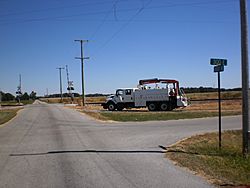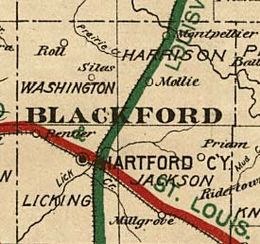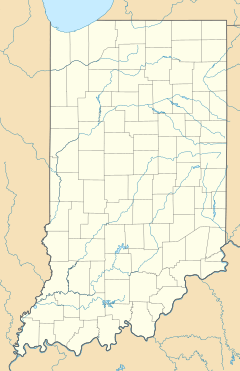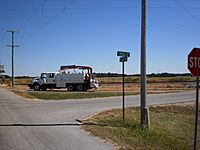Mollie, Indiana facts for kids
Quick facts for kids
Mollie
|
|
|---|---|
|
Extinct village
|
|

Location of Mollie
|
|
| Country | United States |
| State | Indiana |
| County | Blackford |
| Township | Harrison |
| Elevation | 869 ft (265 m) |
| Population
(1980)
|
|
| • Total | 5 |
| Time zone | UTC-5 (EST) |
| • Summer (DST) | UTC-4 (EDT) |
| ZIP code |
47348
|
| Area code(s) | 765 |
Mollie is a ghost town in Blackford County, Indiana. It was once a busy village during the Indiana Gas Boom, from the 1880s to the 1920s. This was a time when lots of natural gas and oil were found in the area.
Mollie was a stop on the Fort Wayne, Cincinnati, and Louisville Railroad. Its location was perfect for oil workers because it was close to the oil fields. Mollie was also about halfway between Hartford City and Montpelier, the two biggest cities in Blackford County.
Besides oil, the land around Mollie was great for farming. Two main roads met there, making it easy for both farmers and oil workers. The small community had a feed mill, a grocery store, a Post Office, and a place to load livestock onto trains. There was also a factory that made bricks and tiles. Mollie is also special because it's believed to be where the first aircraft landed in Blackford County!
Most of Mollie's story is tied to the Indiana Gas Boom. When the gas and oil ran out, the town slowly faded away. Also, the factory's clay supply ran low. And when automobiles became popular, people didn't need trains as much, which made Mollie's railroad stop less important. Today (2011), none of the old businesses are left. Only two houses remain nearby.
Contents
Mollie's History
The small village of Mollie was in Harrison Township in Blackford County, Indiana. It was located where county roads 400 North and 300 East meet, very close to a railroad line. People think the town was named after an early resident named Mollie, but her last name is forgotten. Mollie was never officially planned out; it was just a small group of houses around the train station.
The Gas Boom Years
In 1887, natural gas was found in nearby Hartford City. This started the Indiana Gas Boom in Blackford County. Even more important for Mollie, oil was discovered north of Hartford City in Harrison Township. The first oil well in Blackford County started producing oil in 1890, just south of Montpelier (which is north of Mollie).
By the mid-1890s, about two-thirds of Harrison Township was an oil-producing area. Nearby Montpelier was even called "the very heart of the greatest natural gas and oil field in the world." Mollie was perfectly placed along the railroad line, about 4.5 miles (7.2 km) from Hartford City and 3.6 miles (5.8 km) from Montpelier. This made Mollie a great spot for oil workers during the 1890s. It was lucky to be between two boomtowns, near an oil field, and have train service.
Mollie's Post Office
Mollie had its own Post Office starting on October 19, 1888. Henry H. Dean was the first postmaster. This first Post Office closed after about a year. It reopened on February 6, 1890, with Anderson Hatfield in charge. The Post Office was inside the front of Jacob Burnworth's grocery store.
This Post Office was very helpful for oil field workers. They could easily send and get mail using the railroad. Even though the grocery store burned down in 1891, it was rebuilt. In 1895, Mollie's Post Office was one of seven in Blackford County. The grocery building also had a small waiting room for train passengers.
Mollie's Post Office closed for good in February 1907. Mail for the area then went through Hartford City's Post Office. The postmaster, Jacob Burnworth, felt it was a "waste of time" to keep it open because business had slowed down. Even after the Post Office closed, the grocery store and the waiting station for the interurban (a type of trolley) stayed open in the same building. But in 1914, the grocery store building burned down again because of burning soot.
First Airplane Landing
Near the end of World War I, an army biplane had to land near Mollie. Its engine had failed. This was very exciting news in Blackford County! People paid to ride the trolley (interurban line) to Mollie just to see the airplane. A local historian believes this was one of the first, if not the first, airplanes to land in Blackford County.
Mollie's Location and Land
Mollie is in East Central Indiana, about 44 miles (71 km) south of Fort Wayne, Indiana, and 71 miles (114 km) northeast of Indianapolis.
Underneath Mollie's soil is the Trenton Oil and Gas Field. This field caused the Indiana Gas Boom. Oil production from this field, which was more important to Mollie than natural gas, was at its highest around 1904.
Millions of years ago, two glaciers flattened the land in Northern Indiana, including where Mollie is. These glaciers also made the soil in Blackford County very rich for farming. In the 1890s, farms around Mollie grew "standard cereals, wool and live stock." Today, the area is still mostly farmland. Soybeans and corn are the most common crops in Blackford County. Over 65,000 acres (263 km²) are used for these two crops.
Mollie's Economy

Mollie's economy depended on its railroad stop and farming. The town had a grain elevator, where farmers could load grain and hay onto trains. Farmers also used Mollie's railroad and stockyard to ship their livestock. They would drive cattle or hogs down the county roads to Mollie's stockyard. The animals were often sent to big stockyards in New York or Chicago. Sometimes, livestock like lambs would also arrive in Mollie by train.
Mollie's only factory made tiles. Drainage tiles were very important in Blackford County in the 1800s because the land was originally swampy. The factory made drain tiles, building blocks, and bricks. One of the two houses still standing in Mollie was built using bricks from this local factory. It was easy to ship these products using the nearby railroad.
Other businesses in Mollie included the general store, a cider mill, and a blacksmith shop. These businesses were extra busy during the Indiana Gas Boom because of all the oil field workers nearby.
Mollie's Infrastructure
Mollie is located where county roads 400 North and 300 East meet. A railroad line runs very close to this intersection. In the late 1800s and early 1900s, both passenger and freight trains stopped in Mollie. A grain elevator and stockyard were nearby for local farmers.
Other buildings in Mollie included the tile factory, grocery store, cider mill, and a blacksmith shop. The grocery store later became known as a "general store." Even though Mollie was small, it had at least one doctor, Doctor H. B. Reed.
Railroad Connections
The railroad line next to Mollie was approved in 1849. It connects the Indiana cities of Fort Wayne and Muncie, passing through Montpelier, Mollie, and Hartford City in Blackford County. Building the railroad started in the 1850s, but it wasn't finished until 1870. The original company was called Fort Wayne & Southern Railroad Company. When it started running, it was called Fort Wayne, Cincinnati & Louisville Railroad.
In 1890, the Lake Erie and Western Railroad bought this line. Both names were used during Mollie's busiest years. A short piece of track branched off the main line in Mollie. This "loading track" was 361 feet (110 m) long in 1895 and allowed trains to load and unload goods. Another short branch, the 800-foot (240 m) Manhattan Oil spur, was also nearby. These smaller tracks are gone now, but trains still use the main line.
Around 1905, an interurban line (like a trolley) started running next to the railroad. This interurban connected Mollie to Montpelier in the north and Hartford City in the south. As cars became more popular, people stopped using interurbans. The interurban line in Blackford County was removed in the early 1940s.
Important People in Mollie
Jacob Burnworth was a very important person in Mollie during the Indiana Gas Boom. He moved to Blackford County in 1878. Burnworth owned Mollie's two main businesses: the grocery store and the tile factory. The grocery store building also held a small waiting station for the interurban and the Post Office. Burnworth was the Mollie postmaster and a Justice of the Peace for Harrison Township. He passed away in 1917 at 76 years old.
Mollie's Decline
At the start of the 1900s, the Indiana Gas Boom slowly ended. This was a big reason why many small towns, including Mollie, began to decline. Mollie didn't have big factories that relied on cheap natural gas. However, when the oil workers left the nearby oil fields, there were far fewer customers in Mollie. By 1907, Mollie's Post Office closed because there wasn't enough business. The oil workers had moved away.
Across Blackford County, oil and gas workers left, some factories moved, and businesses closed or cut back. The population of Blackford County reached its highest point in 1900 with 17,123 people. It has not reached that number again, even 100 years later. Mollie was still on maps in the 1920s, but its decline had started two decades earlier.
Other things also contributed to Mollie's decline. Jacob Burnworth, the town's main businessman, owned the general store and the tile factory. The clay used by the tile factory ran out, so the factory moved to Hartford City. Burnworth himself died in 1917.
The rise of the automobile also played a smaller role in Mollie's decline. In the 1900s, cars and roads got much better. This led to fewer people using interurban lines and passenger trains. The last interurban train ran on January 18, 1941. Passenger train service on the main railroad line had already stopped in 1931. Many small towns, like Mollie, had started as train stops. Cars made people less dependent on trains for travel and changed how people shopped, hurting small-town businesses.
By 1972, Mollie's population was down to just 4 people, living in two houses. A funny sign saying "Welcome to Mollie, pop. 4" was kept nearby for drivers to see.
What Remains Today
The land where Mollie once stood, at the intersection of Blackford County roads 400 North and 300 East, is now private farmland. All the old business buildings have been torn down. While the interurban line is gone, the railroad line is still used today. The Norfolk Southern Railway owns and operates the line, connecting Montpelier and Hartford City to other places.




